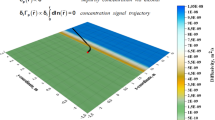Abstract
An asymptotic theory of impurity transport based on advection–diffusion in media with large-scale inhomogeneities is developed. The expression for the concentration is reduced to one-dimensional integrals along the characteristic line called the trajectory of the concentration signal. The trajectory itself is determined from the variational principle—an analog of Fermat’s principle in geometrical optics—which leads to a first-order ordinary differential equation for the unit tangent vector to the trajectory. The asymptotic theory is applicable at distances from the impurity source much larger than the size of the main distribution region of the impurity.

Similar content being viewed by others
REFERENCES
J. P. Bouchaud and A. Georges, Phys. Rep. 195, 127 (1990).
M. B. Isichenko, Rev. Mod. Phys. 29, 961 (1992).
L. A. Bol’shov, P. S. Kondratenko, and L. V. Matveev, Phys. Usp. 62, 649 (2019).
P. S. Kondratenko, JETP Lett. 106, 604 (2017).
L. D. Landau and E. M. Lifshitz, Course of Theoretical Physics, Vol. 8: Electrodynamics of Continuous Media (Pergamon, New York, 1984; Fizmatlit, Moscow, 2005).
L. D. Landau and E. M. Lifshitz, Course of Theoretical Physics, Vol. 3: Quantum Mechanics: Non-Relativistic Theory (Pergamon, New York, 1977; Fizmatlit, Moscow, 2004).
A. M. Dykhne, I. L. Dranikov, P. S. Kondratenko, and L. V. Matveev, Phys. Rev. E 72, 061104 (2005).
P. S. Kondratenko and L. V. Matveev, Phys. Rev. E 75, 051102 (2007).
P. S. Kondratenko and A. L. Matveev, J. Exp. Theor. Phys. 130, 591 (2020).
P. S. Kondratenko, A. L. Matveev, and Yu. N. Obukhov, J. Exp. Theor. Phys. 132, 628 (2021).
P. S. Kondratenko and A. L. Matveev, J. Exp. Theor. Phys. 132, 632 (2021).
P. S. Kondratenko, A. L. Matveev, and A. D. Vasiliev, Eur. Phys. J. B 94, 50 (2021).
L. D. Landau and E. M. Lifshitz, Course of Theoretical Physics, Vol. 1: Mechanics (Pergamon, New York, 1988; Fizmatlit, Moscow, 2001).
Author information
Authors and Affiliations
Corresponding author
Ethics declarations
The authors declare that they have no conflicts of interest.
Additional information
Translated by I. Nikitin
APPENDIX
APPENDIX
The purpose of this section is to find, in the Laplace representation, the impurity concentration cp(r) satisfying Eq. (1) with the initial condition (3) for coordinate-independent diffusivity and advection velocity:
The additional transition to the Fourier representation
reduces the problem to an algebraic one, whose solution is given by the expression
Applying the inverse Fourier transformation to this expression gives
hence, after passing to the new integration variable k′ = k + iu(0)/2D(0), we obtain
Integrating first with respect to the angular coordinates of the vector k and then, using the residue theory, with respect to the absolute value of this vector, we obtain
Hence we find the preexponential factor in the expression for concentration under condition (A.1):
Rights and permissions
About this article
Cite this article
Kondratenko, P.S., Mukharyapova, A.V. Asymptotic Theory of Classical Impurity Transport in Inhomogeneous Media. Fermat’s Principle. J. Exp. Theor. Phys. 135, 714–719 (2022). https://doi.org/10.1134/S1063776122110103
Received:
Revised:
Accepted:
Published:
Issue Date:
DOI: https://doi.org/10.1134/S1063776122110103



